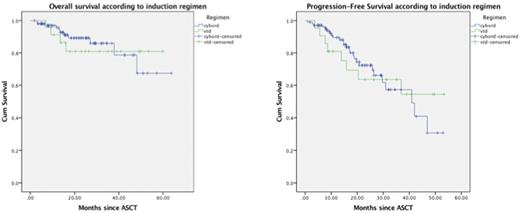Abstract
Introduction: Cyclophosphamide, bortezomib and Dexamethasone (CyBorD) has become the standard frontline approach for the treatment of multiple myeloma (MM) in many centers across Canada. A recent study led by the IFM group showed that the triplet combination of bortezomib, thalidomide and dexamethasone is superior as an induction regimen compared to CyBorD for patients undergoing ASCT. Based on the above-mentioned, we aimed to compare the effect of CyBorD and VTD for the treatment of transplant eligible MM patients in 2 different centers from Canada and Spain. Patients and Methods: The primary objective was to assess ORR and ³VGPR rates after induction and at day-100 post-ASCT, as well as MRD assessed by flow cytometry. Two-sided Fisher exact test was used to test for differences between categorical variables. A p value of <0.05 was considered significant and survival curves were constructed according to the Kaplan-Meier method and compared using the log rank test. Results: 101 patients have received CyBorD and 23 have received VTD. Clinical characteristics are shown in Table 1. At the time of analysis, 90 and 19 patients in the CyBorD and VTD are alive of which 25 and 9, respectively, have progressed. ORR and VGPR rates after a median of 4 cycles of induction were 94% and 56.4% for patients treated with CyBorD, and 91% and 78.2% for VTD, respectively (p=0.3 and 0.05). At day-100 post-ASCT, a ³VGPR rate of 84% and 94% was observed for the CyBorD and VTD groups, respectively (p=0.2). MRD negativity and CR rates were higher in the group receiving VTD (36.8% vs 27%, and 61% vs 38%, p=0.3 and 0.01). Furthermore, median OS and PFS did not differ among both groups (p=0.8 and 0.9, respectively) (Fig1a and Fig1b). In Conclusion: CyBorD and VTD appeared to be effective treatment options for transplant-eligible myeloma patients with similar response rates. Our study is in agreement with that reported by the IFM group, showing a higher rate of³VGPR after induction and day-100 post-ASCT in the VTD group. MRD negativity and CR rate appears also higher in the VTD group suggesting a higher degree of response by using animmunomodulatory drug and a proteasome inhibitor together.
Overall Survival according to treatment regimen
Progression-Free survival according to treatment regimen
Jimenez-Zepeda:Takeda: Honoraria; Amgen: Honoraria; Janssen: Honoraria; Celgene, Janssen, Amgen, Onyx: Honoraria. Bahlis:Janssen: Consultancy, Honoraria, Other: Travel Expenses, Research Funding, Speakers Bureau; Amgen: Consultancy, Honoraria; Onyx: Consultancy, Honoraria; Celgene: Consultancy, Honoraria, Other: Travel Expenses, Research Funding, Speakers Bureau; BMS: Honoraria. Neri:Celgene and Jannsen: Consultancy, Honoraria.
Author notes
Asterisk with author names denotes non-ASH members.



This feature is available to Subscribers Only
Sign In or Create an Account Close Modal